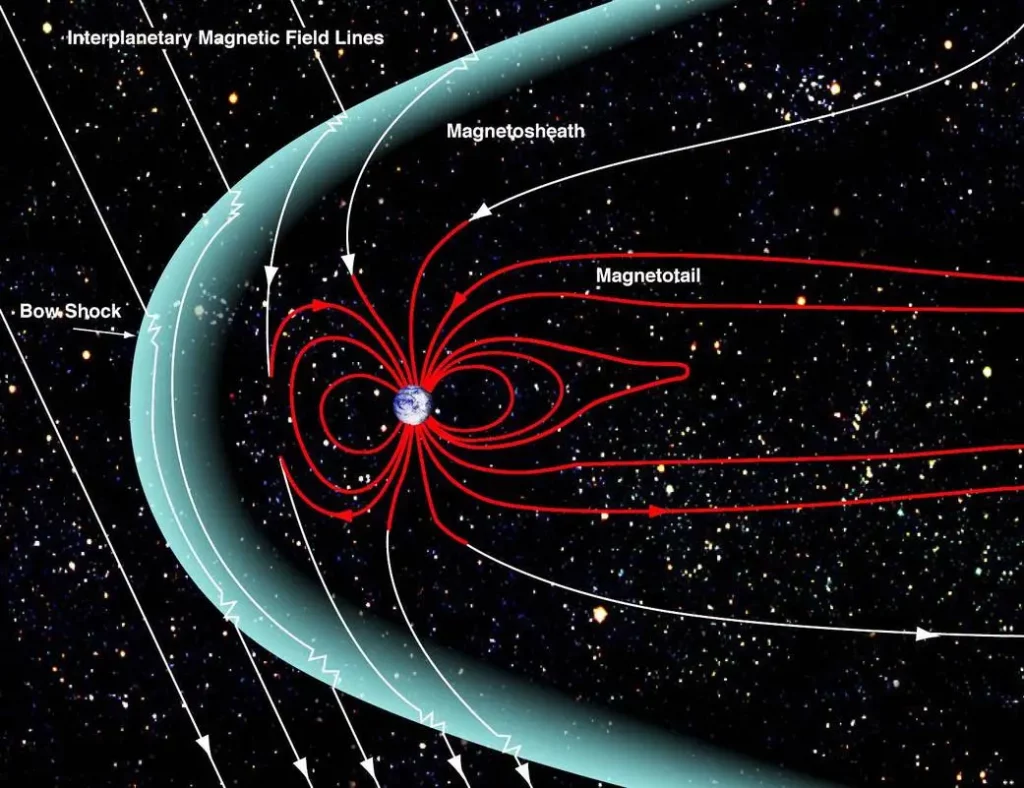The solar wind is a consistent stream of charged particles released from the sun’s atmosphere.
It travels through space, impacting the Earth and other celestial bodies. Our planet is largely protected from the effects of these particles by its magnetic field, which acts as a shield, deflecting the solar wind and preventing it from stripping away the atmosphere.
However, the interaction between the solar wind and the Earth’s magnetosphere is not without its visible effects—auroras, the brilliant displays of light in the polar skies, are a beautiful consequence of this cosmic dance.
Understanding the solar wind is crucial for us, given its potential impact on satellites, space travel, and communication systems.
Charged particles carried by the solar wind can cause geomagnetic storms—disturbances in the Earth’s magnetosphere that can disrupt our technology and pose risks to astronauts in space.
As we continue to explore and rely on space-based technology, our comprehension of the solar wind’s characteristics becomes ever more important.
Observations such as the unexpected disappearance of the solar wind, observed by NASA’s MAVEN spacecraft, add to our reservoir of knowledge. These findings not only hold keys to the historical climate on planets like Mars but also guide us in protecting our modern infrastructures and future ventures into the cosmos.
The Sun as a Source of Solar Wind
The solar wind is a stream of charged particles released from the upper atmosphere of the sun, known as the corona.
These particles consist mainly of electrons and protons, creating a plasma that reaches far into space, affecting planets and the interstellar medium.
Origins of Solar Particles
Solar particles originate in the sun’s corona, the outermost part of the solar atmosphere.
The corona is remarkably hotter than the sun’s surface, with temperatures soaring to several million degrees Celsius.
This intense heat gives the solar particles enough energy to escape the sun’s gravitational pull. As a result, a continuous flow of particles, primarily protons and electrons, radiates outward, forming what we know as the solar wind.
Coronal Mass Ejections and Solar Flares
Coronal Mass Ejections (CMEs) are large eruptions of plasma and magnetic field from the sun’s corona.
They can propel billions of tons of coronal material into space at high speeds.
Solar flares, on the other hand, are sudden flashes of brightness observed over the sun’s surface, indicating the release of immense amounts of energy.
Both phenomena can significantly increase the speed and density of solar wind particles, impacting space weather and potentially leading to geomagnetic storms when they collide with Earth’s magnetosphere.
Earth’s Defense: Magnetosphere and Atmosphere
In protecting our planet, our magnetosphere acts as a shield while the atmosphere plays a key role in mitigating the effects of solar radiation and charged particles.

Our magnetosphere is a vast region of space dominated by Earth’s magnetic field.
It acts as a dynamic barrier to solar wind, a stream of charged particles released from the sun. This shield is critical in preserving our atmosphere from being stripped away by these solar winds.
The magnetic field lines extending from the Earth into space provide a path for these particles, often resulting in the display of auroras, such as the aurora borealis, which are visible evidence of the magnetosphere’s interaction with charged particles.
Atmospheric Interactions
Our atmosphere is not merely a bystander in Earth’s defense; it too actively interacts with incoming solar and cosmic radiation.
When charged particles manage to penetrate the magnetosphere, they collide with atoms and molecules in the atmosphere, resulting in the captivating light shows known as auroras.
These interactions are not just spectacular visuals; they also play a protective role by dissipating energy that could otherwise disrupt satellite operations and power grids on Earth.
Impact on Spacecraft and Technology
Our advancements in space exploration and satellite technology are significantly affected by the Sun’s emissions, known as solar wind.
These streams of charged particles can disrupt spacecraft operations and pose challenges to technology both in orbit and on Earth.
Effects on Satellites and Probes
Satellites and space probes are vulnerable to the impacts of solar wind. High-intensity solar events can lead to:
- Charging of spacecraft surfaces: This can disrupt onboard electronics and damage critical systems.
- Increased drag on low-Earth orbit satellites: Solar events can expand Earth’s atmosphere, increasing drag and potentially altering satellite trajectories.
For instance, NASA’s Parker Solar Probe, designed specifically to study the solar wind, and the Solar Orbiter are equipped with instruments that can withstand harsh conditions to help us understand these effects better.
Space Weather Prediction and Protection
Efficient space weather prediction is critical for the protection of technology in space. We use:
- Advanced forecasting models: To predict solar events and their potential impact on spacecraft systems.
- Protective measures: Such as radiation-hardened electronics and shielded cables to mitigate the effects of charged particle radiation on space technology.
NASA leads in efforts to forecast space weather events and develop protective technologies, ensuring that essential communications and GPS satellites, as well as other critical spacecraft, remain operational during intense solar activity.
Scientific Exploration and Future Research
In our pursuit to understand the Sun’s profound effects on space weather, we’ve embarked on various missions, equipped with advanced technology, to unravel the mysteries of the solar wind.
Our findings not only enhance scientific knowledge but also safeguard space travel and satellite operations.
Missions and Discoveries
NASA has been at the forefront of this quest with missions that parse the intricacies of solar phenomena.
The Parker Solar Probe, named after the pioneering astrophysicist Eugene Parker from the University of Chicago, marked a significant leap.
This spacecraft ventured closer to the Sun than any before it, studying solar wind and the Sun’s outer atmosphere, the corona.
We also have the Solar Orbiter, a collaborative mission with NASA and the European Space Agency (ESA), providing multidimensional views of the Sun.
- Key Discoveries:
- Confirmed predictions of Eugene Parker’s solar wind model
- Detected microstructures in solar wind flow
- Observed the solar corona’s magnetic fields
Challenges in Solar and Space Physics
The study of solar wind presents unique challenges due to its immense velocity and the Sun’s intense radiation.
To overcome these, we develop cutting-edge technology for our spacecraft, allowing them to withstand extreme conditions.
The International Space Station (ISS) serves as a testament to human ingenuity in creating habitable structures in adverse space environments, shielding astronauts from radiation and gravity-related challenges such as:
- Protecting astronauts from solar radiation during space travel
- Anticipating and mitigating the effects of solar storms on Earth and spacecraft systems
As we continue to push the boundaries of our knowledge, each mission yields invaluable data that propels us forward in the fields of solar and space physics.


